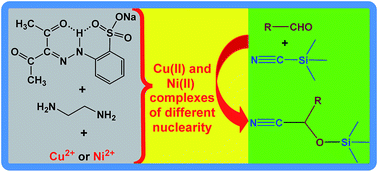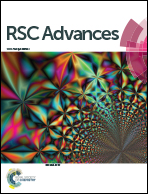Reaction of sodium 2-(2-(2,4-dioxopentan-3-ylidene)hydrazinyl) benzenesulfonate with ethylenediamine on Cu(ii) and Ni(ii) centres: efficient Cu(ii) homogeneous catalysts for cyanosilylation of aldehydes†
Abstract
By reacting copper(II) or nickel(II) salts with sodium 2-(2-(2,4-dioxopentan-3-ylidene)hydrazinyl) benzenesulfonate (NaHL) in an EtOH/H2O solvent mixture and in the presence of ethylenediamine (en), [Cu(HL)2(en)2] (1) or {[Ni(en)3](HL)2}·C2H5OH·6H2O (2) were synthesized, respectively. In MeOH, the coordination polymer [Cu(μ-L1-1κO,NN′N′′:2κO′)]n (3) was obtained, where L1 refers to a dianionic ligand species attained via Schiff-base condensation of NaHL with en on the Cu(II) metal centre, whereas no reaction was obtained in the case of Ni(II). All the compounds were characterised by IR spectroscopy, ESI-MS, elemental and single-crystal diffraction. The Cu(II) compounds 1 and 3 act as effective homogenous catalysts for the cyanosilylation reaction of a variety of aldehydes with trimethylsilyl cyanide affording the corresponding cyanohydrin trimethylsilyl ethers in high yields (up to 93%) and at room temperature.


 Please wait while we load your content...
Please wait while we load your content...